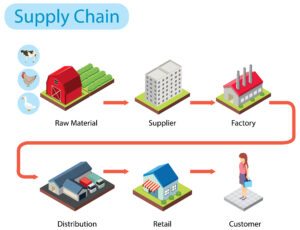ECONOMY
Niger State Housing Corporation, Tis-Buk Realty Limited (private developer) & Refuge Mortgage Bank (funders) to collaborate to provide 10,000 units of housing in Different Local Govt. Areas of Niger State

Niger State Housing Corporation, Tis-Buk Realty Limited (private developer) & Refuge Mortgage Bank (funders) to collaborate to provide 10,000 units of housing in Different Local Govt. Areas of Niger State
The Niger State Government through the State Housing Corporation, Tis-Buk Realty Limited (private developer) and Refuge Mortgage Bank to collaborate for the construction of 10,000 housing Units for low income, middle income and higher income groups of the good people of Niger State and Nigerians.
The Director General, Niger State Housing Corporation, Mr. Bashir Yakubu Harka, The Managing Director/ CEO of Tis-Buk Realty Limited, Engr. Kayode Adeleke and the Managing Director/ CEO of Refuge Mortgage Bank, a foremost Primary Mortgage Institution in Nigeria, Pastor Femi Otenigbagbe agreed that the housing sector is in a key position to mitigate climate change making environmentally friendly affordable housing strategies opportune and crucial.

They also agreed that the housing sector is the single most efficient sector that can, without extra costs, address the issue of climate change. Scaling up efforts of making the housing stock of Niger State and Nigeria more environmentally friendly which can make a great difference in terms of climate change mitigation and adaptation as well as improve quality of life and human wellbeing.
These assertions were made during a physical inspection and working visit to the ongoing construction of Green Dew (Kore Raba) Estate Project on Sunday, December 3, 2023 by the Director General, Niger State Housing Corporation and ED, Operations Mr. Bashir Yakubu Harka and Engr. Abubakar Yakubu (DanGatan Lapal), the Managing Director/ CEO of Tis-Buk Realty Limited, Engr. Kayode Adeleke and the Managing Director/ CEO of Refuge Mortgage Bank, Pastor Femi Otenigbagbe and their entourages.

The Green Dew (Kore Raba) Estate Project is a housing project designed to provide 120 affordable homes consisting of 2-bedrooms, 3-bedroom bungalows and 4 Bedroom Terrace Triplexes + BQ whose location is off the Minna-Bida Road, Kpakungu, Chanchanga Local Government Area, Minna. The Project is a pilot scheme out of the planned 10,000 housing units for Niger State. The Associated infrastructure and amenities include Paved Internal Roads and Drains, Electricity (Solar & Public Power), Water, Sewage treatment, Landscaping. Gatehouse and Perimeter fence, CCTV, Play areas and worship centers.
The Housing units is to be built in Niger State will be through Private Public Partnership (PPP) between Niger State Government through the Niger State Housing Corporation (Land providers) and Tis-Buk Realty Limited (the Developers).
The 10,000-housing development will include: 2,500no of 1 -bedroom Terrace bungalows, 3,000no of 2- bedroom semi-detached bungalows and 4,500no. of 3- bedroom semi- detached bungalows residential housing units and terrace duplexes for sale to members of Cooperative Groups and the General Public. The planned development duration will be 84 months with a projected development cost of N167 billion.
The development will provide Jobs for the youths (both skilled and unskilled), enhance the IGR of the State, enhance the Green economy vision of the Governor Umar Bago Administration and provide great catalyst for the social and poverty alleviation of the Citizens of Niger State and Nigerians in general.
In his remark, The MD/ CEO of Refuge Mortgage Bank stated that they are Tis-Buk Realty Limited strategic financial partners to actualize this objective because the Bank is positioned to through its various housing products and services will provide opportunities for all subscribers. The Bank has also decided to bring its presence to the State capital. The Collaboration between the Stakeholders is the best foot forward In his remarks, the Director General of Niger State Housing Corporation, Mr. Bashir Yakubu Harka disclosed that the project was aimed at providing affordable houses for the people of the state particularly the civil servant and members of the Public. The Housing Corporation is ready to collaborate with the Developer through provision of the needed land banks at different Local Government Areas of Niger State.
Speaking with journalists shortly after the visit of the Niger State Housing Corporation and The Refuge Mortgage Bank entourages, the MD/CEO, Tis-Buk Realty Limited, Engr. Kayode Adeleke noted that the company took interest to embark on the project in Minna as a result of its historic strategic location to Nigeria and the motivational vision actions of the His Excellency, Honorable Umar Bago.
More from my site
BANKING
Financial Analysis: A Comprehensive Study of The Well-Being of A Country

Financial Analysis: A Comprehensive Study of The Well-Being of A Country
Understanding the financial stability of a country requires a thorough understanding of financial analysis. In order to offer insights into the overall financial stability and overall wellness of the country, it entails evaluating a range of economic indicators, financial performance, and market movements.
In this article, we will delve into the fundamentals and importance of financial analysis in evaluating a country’s economic situation.
THE HISTORY ABOUT FINANCIAL ANALYSIS
Ancient Beginnings:
The roots of financial analysis can be traced back thousands of years. The ancient Mesopotamians, Egyptians, and Greeks were among the pioneers of documenting financial transactions, creating basic records of assets and liabilities. These early attempts laid the groundwork for the concept of financial analysis through the study of financial statements and ledgers.
Medieval Europe:
During the Middle Ages, Europe witnessed the rise of merchant guilds and the emergence of double-entry bookkeeping. Italian mathematician and Franciscan friar, Luca Pacioli, is often credited with formalizing double-entry bookkeeping, publishing his seminal work “Summa de arithmetica, geometria, proportioni et proportionalita” in 1494. The concept of balancing debits and credits within financial records formed the basis for modern financial analysis techniques.
Industrial Revolution:
The Industrial Revolution in the 18th and 19th centuries revolutionized business and the need for financial analysis grew rapidly. As companies expanded and diversified, investors began demanding more comprehensive financial reports to assess the potential risks and returns of their investments. The birth of limited liability companies further accelerated the need for financial analysis, as shareholders sought transparency in the performance of their investments.
Modern Era:
The 20th century witnessed significant advancements in financial analysis techniques. The advent of electronic computing in the mid-1900s enabled the processing and analysis of vast amounts of financial data, leading to the development of sophisticated financial models and ratios.
The Great Depression of the 1930s laid the groundwork for modern financial analysis as regulators sought effective ways to prevent future economic crises. The establishment of the U.S. Securities and Exchange Commission (SEC) in 1934 brought about standardized reporting requirements, including the filing of audited financial statements. This increased transparency and standardized financial reporting provided analysts with a more accurate and consistent basis for their analysis.
The Rise of Quantitative Analysis:
In the latter half of the 20th century, the growth of computing power and the availability of large data sets propelled financial analysis into new territory. Quantitative analysis, utilizing statistical models and mathematical algorithms, started gaining prominence. Financial analysts began incorporating complex mathematical methods to assess investment opportunities, risk management, and portfolio optimization.
Modern Financial Tools:
With the advent of the internet and the digital age, financial analysis has become even more accessible and data-driven. Sophisticated software programs, data analytics tools, and artificial intelligence have revolutionized the way financial data is analyzed and interpreted. In recent years, technologies like machine learning have been leveraged to develop predictive models that can assess future trends and make accurate financial forecasts.
MEANING
Financial analysis is the process of evaluating businesses, projects, budgets, and other finance-related transactions to determine their performance and suitability. Typically, financial analysis is used to analyze whether an entity is stable, solvent, liquid, or profitable enough to warrant a monetary investment.
Financial analysis is a fundamental tool that allows organizations and individuals to assess the past, present, and future financial health of a business or investment. Through a systematic examination and interpretation of financial statements, ratios, and other key indicators, financial analysis helps in making informed decisions, optimizing resources, and improving overall financial performance. In this article, we will delve into the meaning of financial analysis, its prominent components, and its significance across various sectors.
Financial analysis involves scrutinizing financial data to evaluate the performance and profitability of an entity. It assists in quantifying the effectiveness of financial decisions, identifying trends, predicting future outcomes, and benchmarking against industry standards. By analyzing financial statements, investors, analysts, and other stakeholders gain valuable insights into the financial position, liquidity, solvency, and operational efficiency of an organization.
FUNDAMENTALS OF FINANCIAL ANALYSIS IN A COUNTRY
- Gross Domestic Product (GDP): GDP is a primary indicator used to gauge the economic performance of a nation. Financial analysts analyze GDP growth rates and its components, such as consumer spending, government expenditure, investments, and net exports. This analysis helps in determining the overall strength of the economy and identifying areas of potential growth.
- Trade and Balance of Payments: Trade analysis focuses on a country’s imports, exports, and balance of payments. Evaluating trade patterns helps identify sectors driving the country’s economic growth, trade imbalances, and potential risks to the economy from external factors such as changes in global demand or disruptions in supply chains.
- Inflation and Interest Rates: Analyzing inflation rates and interest rates provides insights into the stability of a country’s economy. High inflation erodes purchasing power, while high-interest rates can impact borrowing costs, affect consumer spending, and investment behavior. Financial analysts assess the impact of inflation and interest rates on an economy’s overall competitiveness and economic growth potential.
- Government Debt and Fiscal Policy: Analyzing a country’s government debt levels and fiscal policy is crucial in understanding its financial sustainability. A high level of government debt may lead to increased borrowing costs, reduced investor confidence, and potential risks to economic stability. Evaluating fiscal policies helps determine whether a country is managing its finances effectively and implementing sustainable economic growth strategies.
- Stock Market Performance: The stock market reflects investor sentiment and provides valuable insights into a country’s economic outlook. Analysts evaluate key stock market indices, such as the country’s primary exchange, sector-specific indices, and market capitalization trends. Monitoring stock market performance allows for an understanding of investor confidence, economic growth expectations, and potential risks to the financial system.
- Banking Sector and Financial Institutions: A robust banking sector is essential for economic stability. Financial analysts assess the health of the banking system by evaluating indicators such as non-performing loans, capital adequacy ratios, and the overall stability and soundness of financial institutions. Understanding the well-being of financial institutions helps gauge the potential risks to the overall economy, including credit availability, liquidity, and financial contagion.
- Regulatory Environment and Governance: The regulatory environment and governance play a critical role in attracting investment and fostering economic growth. Financial analysts assess the effectiveness of regulatory frameworks, transparency in financial transactions, and the overall credibility and efficiency of institutions responsible for enforcing regulations. Evaluating the regulatory environment aids in understanding potential risks and opportunities for sustainable economic development.
SIGNIFICANCE OF FINANCIAL ANALYSIS IN A COUNTRY
Financial analysis plays a vital role across various sectors, serving the following purposes:
- Evaluating Financial Performance: By conducting a comprehensive financial analysis, companies can assess their performance, profitability, and financial stability. This, in turn, helps in identifying areas for improvement, developing strategic plans, and making sound financial decisions.
- Assessing Investment Viability: Investors rely on financial analysis to evaluate the profitability and risks associated with potential investments. Through detailed scrutiny of financial data, investors can determine the financial health and growth prospects of a company, aiding in making informed investment decisions.
- Facilitating Lending Decisions: Financial institutions utilize financial analysis to assess the creditworthiness of loan applicants. By analyzing financial statements, evaluating ratios, and assessing the risk profile, lenders can ascertain the borrower’s ability to repay loans and make sound lending decisions.
- Supporting Strategic Decision-Making: Financial analysis aids in strategic decision-making, such as expansion, diversification, or mergers and acquisitions. Understanding a company’s financial position and performance provides a foundation for evaluating the feasibility and potential outcomes of such decisions.
CONCLUSION
Conducting a comprehensive financial analysis provides valuable insights into the economic landscape of a country. By evaluating indicators such as GDP, trade patterns, inflation rates, government debt, stock market performance, banking sector health, and regulatory environment, financial analysts can gauge the overall financial health, identify potential risks, and recommend strategies for sustainable economic growth. Accurate and timely financial analysis acts as a compass, guiding policymakers, investors, and businesses to make informed decisions and contribute to the overall prosperity of the nation.
More from my site
BANKING
The Impact of Supply Chain Disruption on Business Operations and Financial Performance

The Impact of Supply Chain Disruption on Business Operations and Financial Performance
Supply chain disruptions are very commonplace in today’s interconnected global economy, affecting organizations in a variety of industries. These interruptions may have far-reaching effects on a company’s financial performance in addition to its commercial operations. In addition to offering techniques to reduce the risks involved, this article seeks to give readers a thorough grasp of how supply chain interruptions affect corporate operations and financial performance.
MEANING OF SUPPLY CHAIN DISRUPTIONS
Any incident or event that prevents information, services, or items from smoothly flowing through the supply chain network is referred to as a supply chain disruption.
It describes any situation or incident that stops the movement of products, services, or data inside a network of supply chains. These interruptions may happen at any time during the supply chain, from suppliers of raw materials to final consumers, and can lead to disruptions, shortages, higher expenses, and eventually affect the chain’s overall effectiveness and performance.
Disruptions to the supply chain can be divided into two categories: internal disruptions that occur within the company and external interruptions that occur outside the company.
TYPES OF SUPPLY CHAIN DISRUPTION
Disruptions to the supply chain can come from a variety of sources and take many different shapes. Typical forms of supply chain disruptions include the following:
- Natural Disasters: Incidents like hurricanes, floods, tsunamis, and wildfires can cause damage to transportation networks, destroy infrastructure, and force the closure of manufacturing and distribution facilities.
- Geopolitical Events: The movement may be impacted by trade disputes, tariffs, sanctions, war, terrorism, political instability, and changes in governmental policy. moving commodities across international borders, sour commercial ties, and cause bottlenecks in the supply chain.
- Supplier Issues: Delays in the delivery of components or raw materials might result from issues with suppliers, such as bankruptcy or sudden changes in production capacity.
- Transportation Disruptions: The supply chain as a whole may be impacted by delays in the delivery of goods caused by strikes, fuel shortages, accidents, port congestion, and other transportation-related problems.
- Demand Surges or Drops: Unexpected fluctuations in customer demand, such as sudden increases in orders or decreases in sales, can result in mismatches between supply and demand, which can cause delays in manufacturing and delivery.
- Cybersecurity Breach: Information technology system malfunctions, cyberattacks, or data breaches can impair critical data, interrupt the flow of products and services, and offerings.
- Quality Control Issues: Recalls, manufacturing halts, and supply chain interruptions may result from issues with product quality, safety, or compliance.
- Pandemics and Health Crises: Situations like the COVID-19 pandemic can result in worker shortages, manufacturing closures, travel restrictions, and interruptions to international supply chains.
IMPACT ON BUSINESS OPERATIONS
Disruptions to the supply chain can have a big effect on how businesses operate, impacting many different parts of what they do. Among these effects are the following:
- Production Delays: Supply chain disruptions may cause delays in the delivery of components, finished goods, or raw materials, which may cause production to halt or slow down. This may affect a business’s capacity to reach production goals and promptly complete orders from customers.
- Increased Costs: Expenses associated with carrying excess inventory, accelerating shipments, finding alternate suppliers, and putting emergency plans in place can all rise as a result of supply chain interruptions. These extra costs have the potential to weaken profit margins and lower overall financial performance.
- Customer Dissatisfaction: Customers may become dissatisfied and lose faith in the business as a result of delays in the delivery of goods or services. Customer loyalty and the company’s reputation may suffer as a result.
- Inventory Management Problems: Disruptions in the supply chain may result in inventory levels that are out of balance, with an abundance of certain commodities and a deficiency of others. This may result in ineffective inventory management, a lockup in working capital, and higher carrying costs.
- Operational Disruptions: When important vendors or partners in logistics are unable to deliver merchandise services as anticipated, it may cause daily operations of a business to be disrupted, affecting departmental productivity and efficiency.
- Risk of Loss of Market Share: Prolonged supply chain interruptions increase the likelihood that a company may miss out on sales opportunities, lose market share, and experience other negative effects. Those with more dependable supply chains could have an advantage over rivals.
- Legal and Regulatory Issues: When a supply chain is disrupted, there may be legal repercussions, including breaking contracts, missing deadlines, and breaking rules. Legal issues, fines, and reputational harm to a business may arise from this.
- Long-term Business Impact: A company’s financial performance, competitive position, and general viability may all be negatively impacted by protracted or severe supply chain disruptions. It might impair the business’s capacity to sustain connections with clients, vendors, and other business associates.
- Communication and Collaboration Challenges: Interruptions can make it difficult for supply chain participants to coordinate, make decisions, and solve problems. Both efficient crisis management and general operational efficacy may be hampered by this.
IMPACT ON FINANCE PERFORMANCE
A company’s financial performance can be significantly impacted by supply chain disruption in a number of ways, including:
- Increased Expenses: Supply chain interruptions frequently result in greater expenses for items like faster shipment, purchasing from more expensive alternative suppliers, keeping extra inventory on hand, or putting emergency preparations in place. The company’s profitability may be directly impacted by these added expenses.
- Revenue Loss: Supply chain disruptions may cause delays in completing client orders, which may result in a potential loss of revenue because lost chances to close deals. If there are delays or product shortages, customers can also look for other suppliers, which would mean fewer sales for the business.
- Inventory Write-offs: When there are disruptions in the supply chain, inventory levels might become unbalanced, with certain items having excess stock and others lacking. As unsold or outdated inventory builds up and negatively affects the company’s financial condition, this may lead to inventory write-offs.
- Contractual Penalties and Legal Expenses: If supply chain disruptions cause a party to miss contractual obligations, there may be penalties and legal expenses. Conflicts involving partners, suppliers, or customers may lead to legal action and more expenses.
- Long-Term Financial Impact: Extended or severe disruptions to the supply chain may have a long-term effect on the financial performance of the business, limiting its capacity to produce revenue and sustain long-term profitability. Stock performance and investor confidence may potentially be impacted by this.
- Working Capital Restraints: In order to minimize disruptions caused by supply chain disruptions, the business may need to store excess inventory or pay in advance for faster transportation. Money that may have been spent for other company endeavors is diverted by this.
- Business Continuity Costs: In order to avoid or lessen supply chain interruptions, businesses may need to make investments in business continuity and risk management techniques. These costs can have an adverse effect on their bottom line.
- Stock Market Reaction: When businesses see significant interruptions in their supply chains, investors may react negatively, which could lead to a drop in stock prices. The market capitalization of the company could be impacted if investors lose faith in its capacity to handle risks.
- Legal and Regulatory Repercussions: Disruptions to the supply chain may result in legal and regulatory repercussions, such as breaking contracts or neglecting to fulfill duties to customers. A company’s reputation and financial performance can be severely impacted by lawsuits, fines, penalties, and compliance expenses.
STRATEGIES FOR MITIGATION
Businesses can handle supply chain disruption and reduce its impact on operations and financial performance by implementing a number of mitigation techniques, such as:
- Diversify Your Supplier Base: Dependence on only one source might make disruptions more likely. Increasing the variety of suppliers helps lessen the effect of interruptions from a particular source.
- Supply Chain Insight: Put in place systems and technology that offer real-time insight into every aspect of the supply chain, including transportation, production status, and inventory levels. This visibility aids in identifying anticipate possible problems and make proactive mitigation strategies possible.
- Risk Assessment and Management: Perform thorough risk analyses of the supply chain to find possible weak points and put risk management plans in place to lessen their effects.
- Contingency Planning: To handle and minimize supply chain interruptions, create and update backup suppliers, logistics routes, and alternate sourcing choices.
- Cooperation and Communication: Create effective channels for cooperation and communication with consumers, logistical partners, and suppliers. Having solid connections and open channels of communication will make it easier to deal with interruptions in a cooperative and efficient manner.
- Inventory Management: Use agile inventory management techniques to balance supply and demand, keep ideal inventory levels, and lessen the effects of shortages and surpluses brought on by disruptions.
- Adoption of Technology: Invest in Supply chain resilience and agility can be improved by utilizing technology like blockchain, supply chain management systems, and predictive analytics.
- Financial Risk Management: To lessen any financial effects, assess your exposure to financial risk as it relates to supply chain interruptions and take into account risk transfer strategies such supply chain insurance.
- Technology Adoption: Supply chain visibility, traceability, and control can be improved by utilizing cutting-edge technologies like blockchain, data analytics, automation, artificial intelligence, and the Internet of Things (IoT). By facilitating real-time monitoring, predictive analytics, and prompt decision-making, these technologies improve resilience and lessen the effects of disruptions.
- Scenario Planning: Create and maintain scenario plans that take into account a range of possible interruptions and how they can affect financial performance and business operations.
CONCLUSION
Disruptions in the supply chain significantly affect financial results and commercial operations. Companies need to proactively identify risks, improve teamwork, use technology, and create strong contingency plans in order to successfully traverse these issues. Businesses may reduce the effects of disruptions, enhance financial performance, and preserve a competitive edge in the complex and unpredictable business world of today by putting these mitigation techniques into practice.
More from my site
ECONOMY
Vehicle Insurance: Everything You Need To Know

More from my site
-
EDUCATION2 years ago
Jamb Cut-Off Mark for A Law Degree in Nigerian Universities
-
BANKING2 years ago
POLARIS Bank Transfer Code| How to Activate the USSD Banking Code
-
BANKING2 years ago
Union Bank Transfer Code| How to Activate the USSD Banking Code
-
BANKING2 years ago
FIRST Bank Transfer Code| How to Activate the USSD Banking Code
-
BANKING2 years ago
How to Check UBA Account Balance From Anywhere
-
BANKING2 years ago
GT Bank Transfer Code| How to Activate the USSD Banking Code
-
BANKING2 years ago
Check GTB Account Balance via Internet and USSD Code
-
BANKING2 years ago
ZENITH Bank Transfer Code| How to Activate the USSD Banking Code






































